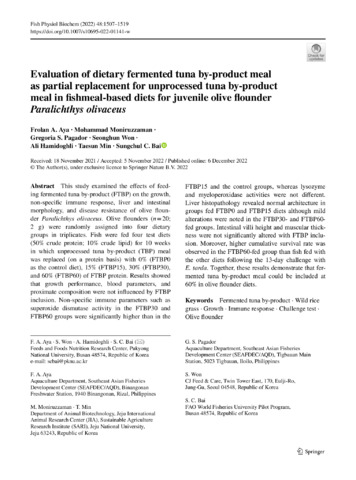Effects of replacing dietary fish oil with beef tallow on growth performance, serological parameters, and fatty acid composition in juvenile olive flounder, Paralichthys olivaceus
- Global styles
- MLA
- Vancouver
- Elsevier - Harvard
- APA
- Help
Share
抄録
This study evaluated the effects of replacing fish oil (FO) with beef tallow (BT) in juvenile olive flounder, Paralichthys olivaceus (3.93 ± 0.07 g), over 8 weeks. Seven diets, consisting of 0, 25, 50, 75, and 100% replacement of FO with BT and 63 and 75.9% replacement supplemented with docosahexaenoic acid (DHA) at 0.9 and 1.1% of 100 g diet, respectively, were distributed into 21 tanks in a semi‐recirculation system with 15 fish per tank. The replacement of FO with BT at the given levels showed no significant changes (p > .05) in growth performance and whole‐body proximate composition. Fish fed the diet of 75.9% replacement with 1.1% DHA supplementation showed the best performance in these measurements among the treatments. Plasma glutamic pyruvic transaminase, cholesterol, high‐ and low‐density lipoproteins, and total protein were not significantly influenced by the replacement of FO with BT. The FO replacement generally resulted in a reduction of eicosapentaenoic acid, DHA, and n‐3/n‐6 polyunsaturated fatty acid ratio in the whole body, whereas the DHA supplementation recovered the level of DHA and the n‐3/n‐6 ratio to those observed in the group fed the 0% replacement diet. Taken together, BT along with DHA supplementation can potentially be a cost‐effective alternative for FO in olive flounder culture.
Keywords
alternative lipid source beef tallow docosahexaenoic acid fatty acid composition fish oil Paralichthys olivaceusSuggested Citation
Lee, S., Aya, F., Won, S., Hamidoghli, A., & Bai, S. C. (2020). Effects of replacing dietary fish oil with beef tallow on growth performance, serological parameters, and fatty acid composition in juvenile olive flounder, Paralichthys olivaceus. Journal of the World Aquaculture Society , 51(2), 393-406. https://doi.org/10.1111/jwas.12654
Type
ArticleISSN
0893-8849; 1749-7345Collections
- Journal Articles [1256]
Related items
Showing items related by title, author, creator and subject.
-
Interactive effects of vitamin C and E supplementation on growth performance, fatty acid composition and reduction of oxidative stress in juvenile Japanese flounder Paralichthys olivaceus fed dietary oxidized fish oil
Gao, Jian; Koshio, Shunsuke; Ishikawa, Manabu; Yokoyama, Saichiro; Mamauag, Roger Edward (Elsevier, 2014)
A study was conducted to determine the interactive effects of vitamin C (VC) and E (VE) supplementation on growth, fatty acid composition and oxidative status of Japanese flounder juveniles. Fish (initial average body ...
(Elsevier, 2014)
A study was conducted to determine the interactive effects of vitamin C (VC) and E (VE) supplementation on growth, fatty acid composition and oxidative status of Japanese flounder juveniles. Fish (initial average body ... -
Evaluation of dietary fermented tuna by-product meal as partial replacement for unprocessed tuna by-product meal in fishmeal-based diets for juvenile olive flounder Paralichthys olivaceus
Aya, Frolan ; Moniruzzaman, Mohammad
; Moniruzzaman, Mohammad  ; Pagador, Gregoria E.; Won, Seonghun
; Pagador, Gregoria E.; Won, Seonghun  ; Hamidoghli, Ali
; Hamidoghli, Ali  ; Min, Taesun; Bai, Sungchul C. (Springer, 2022-12-06)
This study examined the effects of feeding fermented tuna by-product (FTBP) on the growth, non-specific immune response, liver and intestinal morphology, and disease resistance of olive flounder Paralichthys olivaceus. ...
; Min, Taesun; Bai, Sungchul C. (Springer, 2022-12-06)
This study examined the effects of feeding fermented tuna by-product (FTBP) on the growth, non-specific immune response, liver and intestinal morphology, and disease resistance of olive flounder Paralichthys olivaceus. ... -
Mass larval rearing technology of marine finfish in Japan
Fukusho, Kunihiko (Aquaculture Department, Southeast Asian Fisheries Development Center, 1996)With economic development and increased demand for high price fish, industrial scale marine finfish culture in Japan was started in 1960-1965 for yellowtail Seriola quinqueradiata. Sustainable supply of wild juvenile and ...





